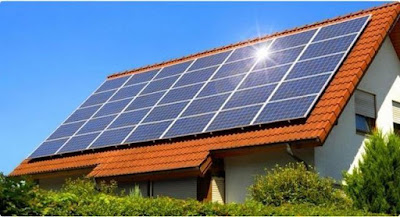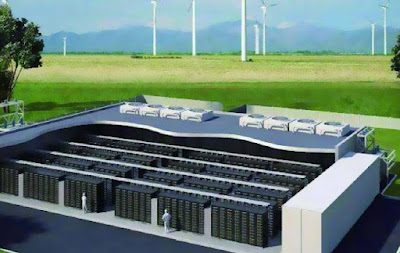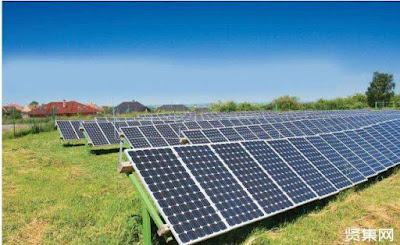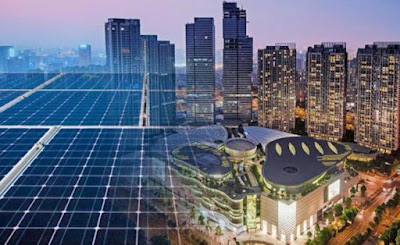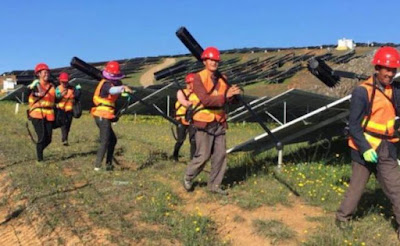Now that the weather continues to be hot and hot, some people have a sudden idea: Taking advantage of the east wind of the photovoltaic industry, if we directly cover the city with solar panels, it will not only solve the problem of electricity consumption, but also not get hot, is this kind of project feasible?
1. China also has this idea at the national level, and is developing the whole county of photovoltaics in an orderly manner
One of my classmates is in a central power company and is currently doing photovoltaic development. He said this, if they can outsource the right to develop photovoltaics in a city, they can install photovoltaic panels everywhere. And the country also has this idea, so it is successively engaged in photovoltaic development projects in the whole county.
In other words, this is already being done, but the cost of urban transformation is relatively high, so we can only start from the towns and counties with better lighting.
For example, Gonghe County, Qinghai Province, its photovoltaic panels cover more than 609 square kilometers, which is almost the size of Singapore.
According to reports, the average annual power generation of the photovoltaic industry in Qinghai Province is as high as 80 million kilowatt-hours. In addition to meeting the consumption in the province, the power supply of these clean energy can also be delivered to Jiangsu, Henan and other places, and also drive nearly 1.2 million public welfare poverty alleviation jobs. post.
It can be seen that this idea is very interesting. For the sake of sacrifice, I dare to call the sun and the moon a new sky. Of course, we also need to know that the current solar panels cannot prevent the sun from being heated, and the power generation efficiency is about 20%, and 80% of the sunlight energy will still be converted into heat energy. Therefore, even if the city is fully covered, the temperature will not change much from normal.
However, as long as 20% of the heat energy used in the city is converted, it is equivalent to 20% less electricity input to the city from the outside. So, is full coverage of solar cells in cities feasible?
2. Do the math: How high is the input cost if the city is covered with solar cells to generate electricity?
Take the city of Shanghai as an example: it costs about 100 to 120 yuan per square meter to mount a glass panel or solar panel to a bracket about 6 meters high on the flat ground. In the city, the total cost will increase if the support has to adapt to the existing buildings and terrain fluctuations, cope with the impact of terrain obstacles and various weathers, occupy part of the built-up area, and acquire land if necessary.
In addition, the cost of solar panels is about 270 to 740 yuan per square meter, and at least about 40 yuan per square meter is required for maintenance each year. Moreover, the urban area of Shanghai's central area is about 664 million square meters, and there are a lot of building height differences. Covering this area requires the cost of brackets and solar panels to exceed 1 trillion yuan. Do you think this cost is acceptable?
At the same time, solar panels will not completely prevent the heating caused by sunlight, and the urban air flow, lighting, rainwater treatment and other aspects under the coverage need additional design, as well as land acquisition, procurement, construction, etc., and the cost of supporting equipment is at least hundreds of billions of yuan.
Let's look at Shanghai's GDP of 3.87 trillion yuan in 2020, general public budget revenue of 704.63 billion yuan, and general public budget expenditure of 810.21 billion yuan. Shanghai has so much money to spend to build such a project?
And every year, these solar panels require tens of billions of dollars in maintenance costs, and each solar panel needs to be replaced and scrapped after about 25 to 30 years, which is no less expensive than rebuilding.
Under the condition of Shanghai's annual average illumination, the above-mentioned solar panels can generate about 110 billion kWh of electricity each year, and the power fluctuates greatly with time and weather. In 2020, Shanghai's electricity consumption is about 157.6 billion kWh. That said, the aforementioned solar panels are not enough, even if they cost a fortune.
To sum up, even without considering the technical details, the above-mentioned projects are unprofitable at the current productivity level, and it is natural that no one is going to engage in urban full-coverage projects.
3. The types of projects covered by solar panels have indeed appeared in cities.
This can actually be discussed, and it may not be practical to cover it completely, but it is reasonable to install it on the roof, canopy, etc. It can also add some solar awnings to the sidewalks with high traffic to facilitate travel in summer and rainy days.
It can be seen that in the current city, the types of projects covered by solar panels have indeed begun to appear. And they all have one thing in common, in addition to generating electricity, there are other benefits.
One is the closed awning on the roof terrace. Originally it was not allowed to build, but in the name of solar energy, it was allowed to build. There is a lot of extra use area, which is old and valuable, so it doesn't care about the investment income ratio of solar energy itself.
Second, the roof of the villa is also a photovoltaic power generation resource. Only 24,000 yuan can be installed to install 7,000 watts of photovoltaic panels. In the southern region, 7,000 kWh of electricity can be obtained every year. According to the annual per capita electricity consumption of more than 800 kWh in China, it is enough for a family of three.
The third is the solar awning of the parking lot. Originally, the parking lot had to build awnings and charging piles. By the way, the solar awning can be built to generate electricity and supplement electricity, and the benefits will come out.
Fourth, street lamps, decorative lanterns. In some places, it is very troublesome to pull the wires. Using a solar panel to supply energy to the street lights saves a lot of trouble, and the benefits can be shown.
In short, with the improvement of solar panel efficiency, cost reduction, and precise policy guidance, the coverage area of solar panels in cities will inevitably increase, but this must also be a gradual process.
Final words: Urban photovoltaics have a large space for imagination, and technology is developing. We must make use of our strengths and avoid our weaknesses, and we must not give up food because of choking.
We need to know that in many countries, the difference between the use of the public grid and the on-grid electricity price may be as high as 1RMB/kWh. As the price of lithium batteries decreases, for example, Volkswagen expects that the price of lithium batteries will drop to $50/kWh in 2030, even if it is completely dependent on photovoltaics and battery energy storage, it may be more cost-effective than the public grid.
Of course, China has a vast territory and uneven distribution of sunlight resources. Most of the major cities are areas with Class II and Class III sunlight resources. On the contrary, the northwestern desert and other regions have more than 2,000 hours of sunshine throughout the year, which belongs to the first-class light resource area. According to preliminary calculations, only the Taklimakan Desert is fully equipped with photovoltaic panels, which can be more than enough to supply the world's electricity demand. Easy first and then difficult, urban photovoltaic imagination is also very large, let us wait and see.
